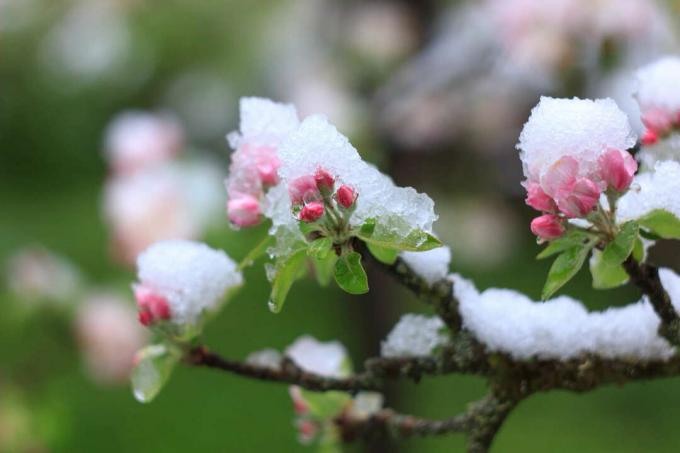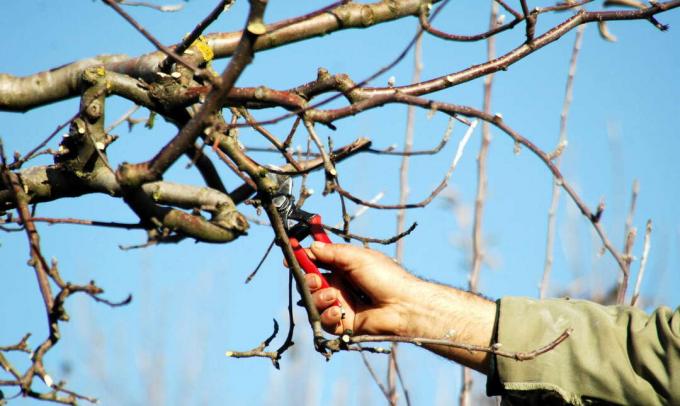For apples, the flowering time is the most critical time. It is decided how the yield will be. We show you what to watch out for when blooming.

Apple trees (Malus domestica) already form the flower buds for the coming year in early summer. Because the plants are in hibernation and have their own frost protection mechanisms, they get through the cold season well. In spring, however, the protective mechanisms are deactivated and the young flower buds awaken as soon as they have one have experienced a certain period of cool temperatures and drift as a result at suitable, warm and sunny Conditions. This stimulus to sprout as a result of cool temperatures is called vernalization. This mechanism is not only found in apples, but also in many other plants. As a rule, however, the blossoms in apples appear at a time when frosty temperatures can still prevail. Then it becomes critical for the apple blossom: late frosts in spring can destroy the entire apple harvest.
contents
- Protect apple blossom from late frost
- Apple blossom: thin out too many blossoms and small fruits
- The apple tree does not bloom: why is that?
Protect apple blossom from late frost
The blossoms of the apple trees are particularly sensitive when they are already wide open. Late frosts are therefore a big problem for the trees. Even when planting, however, you can pay attention to a few things in order to protect the plants from threatening late frosts. A sheltered and less wind-prone location helps a lot to protect against frost. You can also use an air-permeable fleece to protect your apple tree from frost on cold nights when the apple is in bloom. Some old apple varieties are also less susceptible to frost, so growing them can be worthwhile.
Other methods of frost protection of the flowers are used in commercial cultivation, for example frost protection irrigation. The trees are constantly sprayed with water, creating an ice sheet around them. Due to the heat of crystallization of the freezing water, the temperature inside does not drop below zero and the flowers do not freeze to death. Fruit growers also install fire barrels in their plantations and "heat up" their blossoming apple trees on cold nights to protect the sensitive blooms from failures.

Apple blossom: thin out too many blossoms and small fruits
Many apple trees produce more fruit than they can feed. As a result, the fruits stay small. The best way to encourage the formation of the fruit is to thin out your apple tree. The tree itself sheds the unfertilized flowers when it falls in June. If there are still too many blossoms on the apple tree, remove them by hand. Remove too close or damaged apples as soon as you recognize them. Two to three apples per short shoot are an optimal number in order to create a perfect ratio between quantity (harvested amount) and quality (size and taste of the apples).

The apple tree does not bloom: why is that?
If your apple tree does not bloom in the first year, there is no reason to panic. Young trees take a few years to bloom. With a self-grown seedling, it takes significantly longer than with a grafted specimen (read more about the Grafting apple trees). Depending on the variety, it can take 5 to 10 years until the first harvest. Conversely, the tree can also be too old and is already in "retirement", so that it no longer blooms or, at best, very sparsely.

If you can observe an annual dependency in the abundance of the apple blossom, then you have become aware of the so-called "alternation". A good flowering and harvesting year will be followed by a year with significantly less flowering and fewer fruit set. For this reason, too, the blossoms in apple orchards are specifically thinned out in order to achieve a balanced number of blossoms per tree every year and thus a uniform harvest.
In general, one should keep in mind that the apple tree does not bear fruit on annual shoots. The pruning in winter therefore plays a major role. To make sure that you can reap a harvest in the coming year, you have to be careful not to cut off all biennial or perennial shoots. Even the most abundant new shoots will not ensure an equally abundant harvest, because the newly sprouted shoots will not bear any fruit. It should be noted that some varieties, such as'Red star ribbon‘Prefer to form their buds further forward on the shoots. In this case, shortening the shoots too much prevents the formation of flowers and thus also fruit.

In addition to the age of the tree, the alternation and a poor pruning, there may be other reasons for the failure of the apple to blossom:
- Bad growth
- Over-fertilization: Too much nitrogen stimulates the plants to vigorous vegetative growth of roots, shoots and leaves - fruit formation and flowering fall by the wayside
- Old age
- Pest infestation (important Diseases and pests in the apple tree You will find here)
tip: If you use a predominantly organic organic fertilizer like ours Plantura organic universal fertilizer overfertilization is virtually impossible, as the nutrients are only released slowly and gently to the apple tree.
The reasons for the lack of apple blossom can be varied. In some cases, you can specifically help your apple tree to bloom abundantly and successfully. But even the blooming of the tree is no guarantee of a good harvest. Frost damage can always thwart your plans.
All information about Apple trees - from cultivation to care to harvest - you will find this special article.

